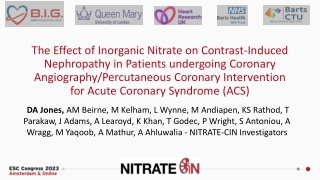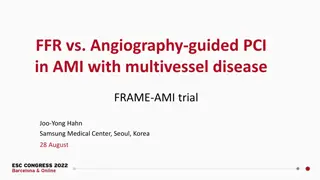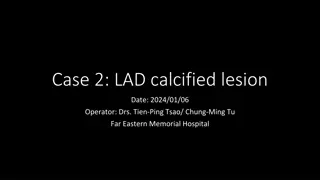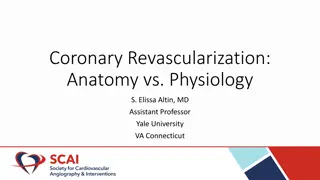Best Practices for Transradial Angiography & Intervention Update
Expert consensus statements provide guidance on utilizing ultrasound guidance for arterial access, preferring radial over ulnar artery access, and the utility of non-invasive collateral flow assessment. Recommendations include administering heparin post-sheath placement and using low-profile sheaths for procedural success to prevent radial artery occlusion.
Download Presentation

Please find below an Image/Link to download the presentation.
The content on the website is provided AS IS for your information and personal use only. It may not be sold, licensed, or shared on other websites without obtaining consent from the author.If you encounter any issues during the download, it is possible that the publisher has removed the file from their server.
You are allowed to download the files provided on this website for personal or commercial use, subject to the condition that they are used lawfully. All files are the property of their respective owners.
The content on the website is provided AS IS for your information and personal use only. It may not be sold, licensed, or shared on other websites without obtaining consent from the author.
E N D
Presentation Transcript
SCAI Update on Best Practices for Transradial Angiography & Intervention Slides developed by: Adhir R. Shroff, MD, MPH, FSCAI (Chair)
SCAI Expert Consensus Statement Update on Best Practices for Transradial Angiography & Intervention Adhir R. Shroff, MD, MPH, FSCAI (Chair); Rajiv Gulati, MD, PhD, FSCAI (Co-Chair); Douglas E. Drachman, MD, FSCAI; Dmitriy N. Feldman, MD, FSCAI; Ian C. Gilchrist, MD, FSCAI; Prashant Kaul, MD, FSCAI; Kusum Lata, MD, FSCAI; Samir B. Pancholy, MD, FSCAI; Carmelo J. Panetta, MD, FSCAI; Arnold H. Seto, MD, FSCAI; Bernadette Speiser, BSN, MSN, CCRN, RCIS; Daniel H. Steinberg, MD, FSCAI; Mladen I. Vidovich, MD, FSCAI; Walter W. Woody, MD, FSCAI; Sunil V. Rao, MD, FSCAI Shroff, AR, Gulati, R, Drachman, DE, et al. SCAI expert consensus statement update on best practices for transradial angiography and intervention. Catheter Cardiovasc Interv. 2020; 95: 245 252. https://doi.org/10.1002/ccd.28672
Ultrasound Guidance for Arterial Access Operators should develop proficiency with ultrasound guidance to facilitate forearm vascular access. Real-time ultrasound guidance should be available and used when difficulty with radial access is encountered or expected.
Ulnar Artery Access Radial artery access is preferred over ulnar artery access in most situations. The ulnar artery may be a reasonable alternate access site when the risks of radial access failure or complication are high (e.g. small radial diameter, calcification, tortuosity or anatomic anomaly). The ipsilateral ulnar artery may be a reasonable secondary access site after failed radial access, however, the data are limited. In cases of radial artery occlusion, there are insufficient data to provide a recommendation on the use of the ipsilateral ulnar artery over alternate access sites such as the contralateral radial or femoral arteries.
Utility of Non-Invasive Assessment of Collateral Flow or Palmar Arch Patency Transradial catheterization can be performed regardless of results of non-invasive collateral testing. Routine collateral testing should not be used as a triage tool for access site selection. Collateral testing may be useful in screening for post-procedural radial artery occlusion and in assessing the adequacy of hemostasis techniques.
Prevention of Radial Artery Occlusion Updated or New Recommendations Administration of intravenous or intra- arterial unfractionated heparin 5000 U or 50 U/kg or a higher dose as a bolus is recommended following placement of radial artery introducer sheath. Concomitant ipsilateral ulnar artery compression is recommended to further maximize radial artery patency. Continued Recommendations Use of lowest profile sheath and/or catheter system required for procedural success, with attention to sheath/catheter-to-artery ratio. Patent hemostasis should be the default strategy, regardless of the method or device used for compression of the arteriotomy.
Radial access for primary PCI for STEMI Transradial access (TRA) should be the default access route for ST elevation myocardial infarction (STEMI) PCI revascularization for operators and in cardiac catheterization laboratories with appropriate training and expertise. Operators should become experienced with non-emergent TRA PCI prior to performing STEMI TRA PCI. Appropriately defined strategies for arterial access site crossover (contralateral radial or femoral) should be in place to facilitate the decision process during emergencies in order to avoid delays in revascularization and ensure optimal outcomes.























